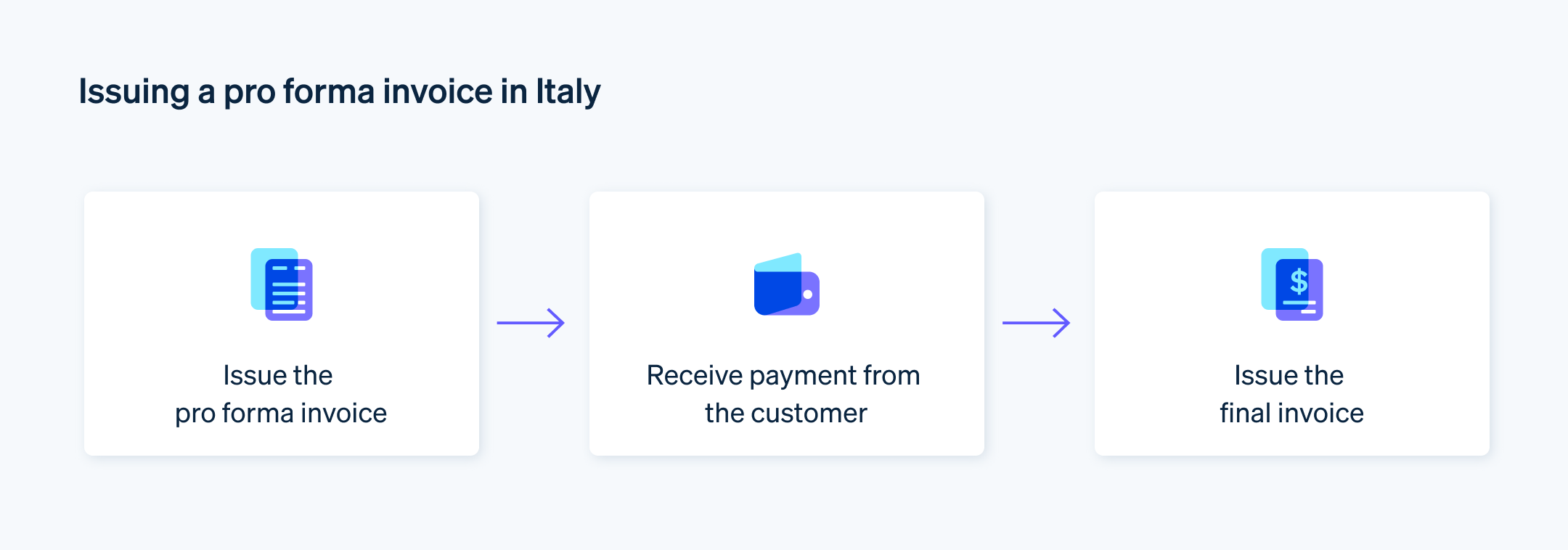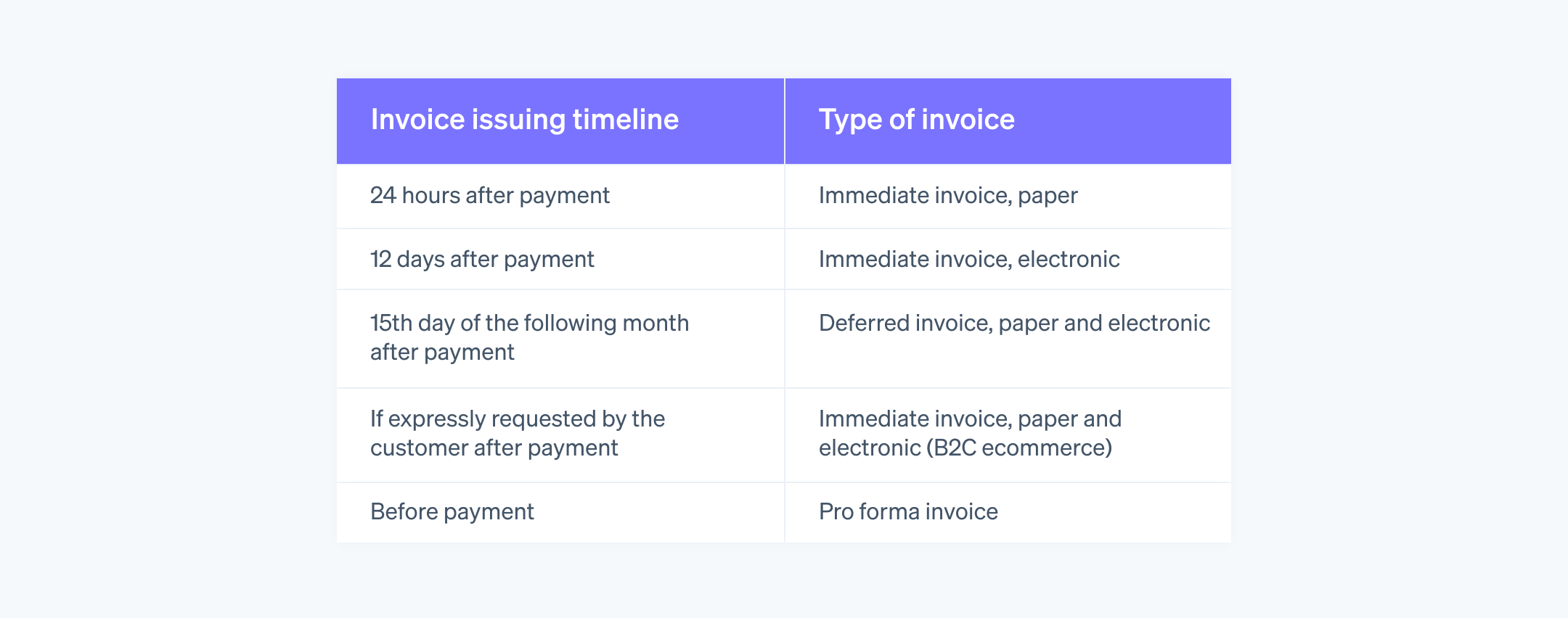Das italienische Recht sieht je nach Art der Transaktion (d. h. Verkauf beweglicher oder unbeweglicher Sachen oder Erbringung von Dienstleistungen) unterschiedliche Fristen für die Ausstellung von Rechnungen vor. Die Fristen richten sich auch danach, ob es sich um eine Sofort- oder um eine aufgeschobene Rechnung handelt.
Im Folgenden erläutern wir die rechtlichen Anforderungen an die Ausstellung einer Rechnung, ob sie vor oder nach der Zahlung ausgestellt werden sollte, was eine Pro-forma-Rechnung ist und welchen Zweck sie erfüllt.
Worum geht es in diesem Artikel?
- Rechtliche Voraussetzungen für die Rechnungsstellung
- Ausstellung einer Rechnung vor oder nach der Zahlung
- Rechnung nach Zahlung: Die Pro-forma-Rechnung
- Wann wird eine Rechnung nach der Zahlung ausgestellt?
Rechtliche Anforderungen an die Ausstellung einer Rechnung
Die Pflicht zur Ausstellung einer Rechnung ist in Artikel 6 des Präsidialdekrets 633/1972 geregelt und hängt davon ab, ob es sich beim Verkauf um bewegliche Sachen, Immobilien oder die Erbringung von Dienstleistungen handelt.
Verkauf von beweglichen Sachen: Der Verkauf gilt zum Zeitpunkt der Lieferung oder des Versands der Ware als erfolgt. Eine Rechnung kann entweder vor oder nach der Zahlung ausgestellt werden.
Verkauf von Immobilien: Es wird davon ausgegangen, dass die Transaktion am Tag der Vertragsunterzeichnung erfolgt. Die Veräußerin/der Veräußerer muss eine Rechnung ausstellen, wenn das Eigentum an der Immobilie übertragen wird.
Erbringung von Dienstleistungen: Die Leistungserbringung gilt mit Zahlungseingang als abgeschlossen. Für Abrechnungszwecke gilt die Leistung als abgeschlossen, wenn die Zahlung eingegangen ist. Auch hier kann eine Rechnung entweder vor oder nach der Zahlung ausgestellt werden.
Von diesen Regeln gibt es zwei Ausnahmen:
Frühere Ausstellung einer Rechnung
Wenn die Rechnung vor Abschluss der Transaktion ausgestellt wird – beispielsweise vor Vertragsabschluss (bei Immobilien), vor der Lieferung/dem Versand der Waren (bei beweglichen Sachen) oder vor der Zahlung (bei Dienstleistungen) – gilt die Transaktion gemäß Artikel 6 dennoch als abgeschlossen.
Daher gilt bei einer Vorausrechnung das Ausstellungsdatum der Rechnung als das Datum der Transaktion. Eine Vorabrechnung ist eine formelle Rechnung, die alle rechtlichen Anforderungen erfüllen muss.
Vorausrechnung
Wenn Käufer/innen eine Anzahlung leisten, bevor sie die Ware erhalten, muss die Lieferantin/der Lieferant eine Rechnung über die Anzahlung ausstellen.
Erfolgt für die Erbringung von Dienstleistungen eine Anzahlung, konstituiert die Anzahlung in der Regel die Transaktion. In diesem Fall muss die Rechnung für die Vorauszahlung innerhalb von 12 Tagen ab dem Datum des Zahlungseingangs ausgestellt werden.
Ausstellung einer Rechnung vor oder nach der Zahlung
Üblich ist, die Rechnung unmittelbar nach dem Verkauf der Waren oder der Erbringung von Dienstleistungen auszustellen und die Zahlung später auf der Grundlage der vereinbarten Bedingungen zu erhalten. In der Praxis ist dieser Ansatz der einfachste, da er sicherstellt, dass die Rechnung pünktlich ausgestellt wird und mögliche Strafen für eine verspätete Ausstellung vermieden werden. Das Gesetz verlangt jedoch nicht unbedingt, dass die Rechnung vor der Zahlung ausgestellt wird. In vielen Fällen wird sie nach der Zahlung ausgestellt.
Wenn Sie die Rechnung nach der Zahlung ausstellen, hängt die Zeit, die Sie dafür haben, in erster Linie davon ab, ob es sich um eine Sofort- oder um eine aufgeschobene Rechnung handelt:
Innerhalb von 24 Stunden: Für eine sofortige Papierrechnung (für diejenigen, die weiterhin berechtigt sind, eine solche auszustellen)
Innerhalb von 12 Tagen: Für eine sofortige elektronische Rechnung
Bis zum 15. Tag des Folgemonats: Bei der aufgeschobenen Abrechnung, unabhängig davon, ob die Rechnung in Papierform oder elektronisch vorliegt
Rechnung nach Zahlung: Die Pro-forma-Rechnung
Ein gängiges Beispiel für die Ausstellung einer Rechnung nach der Zahlung ist, wenn sie auf eine Pro-forma-Rechnung folgt. Eine Pro-forma-Rechnung ist keine steuerlich gültige Rechnung, sondern nur eine Kostenaufstellung. Sie ist vor Abschluss der Vereinbarung von der Lieferantin/dem Lieferanten und der Kundin/dem Kunden und vor der Ausstellung der offiziellen Rechnung zur Überprüfung vorgesehen.
Die Pro-forma-Rechnung kann auch mit einer Software für die elektronische Rechnungsstellung erstellt werden, wobei ein entsprechender Text hinzugefügt wird, um anzuzeigen, dass die Rechnung für Steuerzwecke nicht gültig ist.
Wozu dient eine Pro-forma-Rechnung?
Für Geschäftsinhaber/innen kann eine Pro-forma-Rechnung aus folgenden Gründen nützlich sein:
Vor der Zahlung ausgestellt: Auf diese Weise vermeiden Sie, dass Steuerverpflichtungen entstehen, bevor Sie die Zahlung erhalten haben. Tatsächlich werden die meisten Steuern, einschließlich der Umsatzsteuer (USt.), auf der Grundlage des Rechnungsdatums berechnet, unabhängig davon, ob die Zahlung bereits eingegangen ist.
Jederzeit änderbar: Eine Pro-forma-Rechnung ist ein nicht steuerpflichtiges Dokument, das geändert werden kann. Daher entfällt durch die Verwendung einer Pro-forma-Rechnung die Notwendigkeit, im Fehlerfall eine Stornorechnung auszustellen.
Auf Korrektheit überprüft: Kundinnen/Kunden, die eine Pro-forma-Rechnung erhalten, können die Preise, die Beschreibung von Dienstleistungen oder Produkten und die Richtigkeit der angezeigten Informationen überprüfen.
Merkmale einer Pro-forma-Rechnung
Die Hauptmerkmale einer Pro-forma-Rechnung sind:
Ausstellungsdatum: Die Pro-forma-Rechnung wird vor der Zahlung ausgestellt, während die Schlussrechnung erst erstellt werden kann, nachdem der Kunde/die Kundin den fälligen Betrag beglichen hat. Die Ausstellung der Schlussrechnung ist obligatorisch, da sie das einzige Dokument ist, das die Transaktion steuerlich relevant macht.
Konvertierung von Rechnungen: Eine Invoicing-Software ermöglicht die einfache Umwandlung einer Pro-forma-Rechnung in eine Schlussrechnung in nur wenigen Schritten.
Nummerierung: Die Nummerierung der Pro-forma-Rechnung unterscheidet sich vollständig von der auf der Schlussrechnung.
Notwendige Informationen: Die folgende Erklärung muss der Pro-forma-Rechnung beigefügt werden: „Dieses Dokument stellt keine gültige Rechnung im Sinne des DpR 633 vom 26.10.1972 in der aktuellen Fassung dar. Die Schlussrechnung wird nach Eingang des fälligen Betrages ausgestellt (§ 6 Abs. 3 DpR 633/72).“

Mit zunehmendem Unternehmenswachstum wird auch die Verwaltung des Rechnungsstellungsprozesses immer komplexer. Es gibt Tools, mit denen sich dieser Prozess automatisieren lässt, wie z. B. Stripe Invoicing, eine umfassende und skalierbare Rechnungsplattform, mit der Sie Rechnungen für einmalige und wiederkehrende Zahlungen erstellen und versenden können, ohne Code schreiben zu müssen. Mit Invoicing sparen Sie Zeit und werden schneller bezahlt, da 87 % aller Stripe-Rechnungen innerhalb von 24 Stunden eingezogen werden. Dank Drittpartnern können Sie Invoicing auch für die obligatorische elektronische Rechnungsstellung nutzen.
Wann wird eine Rechnung nach der Zahlung ausgestellt?
Es bleibt dem Unternehmen überlassen, ob es die Rechnung vor oder nach der Zahlung ausstellt. Häufig stellen Unternehmen oder Freiberufler/innen wie Rechtanwältinnen/Rechtsanwälte, Notarinnen/Notare oder Steuerberater/innen die Rechnung nach der Zahlung aus und verwenden zuvor eine Pro-forma-Rechnung. Die Kundin/der Kunde zahlt auf Grundlage der Pro-forma-Rechnung, und die Lieferantin/der Lieferant stellt dann die Schlussrechnung aus. Dies ist eine übliche, aber nicht obligatorische Praxis. Freiberufler/innen oder Unternehmen können die Schlussrechnung auch ausstellen, bevor die Zahlung eingegangen ist.
Auch wenn Produkte und Dienstleistungen online gekauft werden, erfolgt die Zahlung in der Regel per Vorkasse, bevor die Waren oder Dienstleistungen empfangen werden. In diesen Fällen wird die Rechnung – optional im Business-to-Consumer(B2C)-E-Commerce, sofern vom Kunden/von der Kundin nicht ausdrücklich gewünscht – nach der Zahlung ausgestellt.

Der Inhalt dieses Artikels dient nur zu allgemeinen Informations- und Bildungszwecken und sollte nicht als Rechts- oder Steuerberatung interpretiert werden. Stripe übernimmt keine Gewähr oder Garantie für die Richtigkeit, Vollständigkeit, Angemessenheit oder Aktualität der Informationen in diesem Artikel. Sie sollten den Rat eines in Ihrem steuerlichen Zuständigkeitsbereich zugelassenen kompetenten Rechtsbeistands oder von einer Steuerberatungsstelle einholen und sich hinsichtlich Ihrer speziellen Situation beraten lassen.